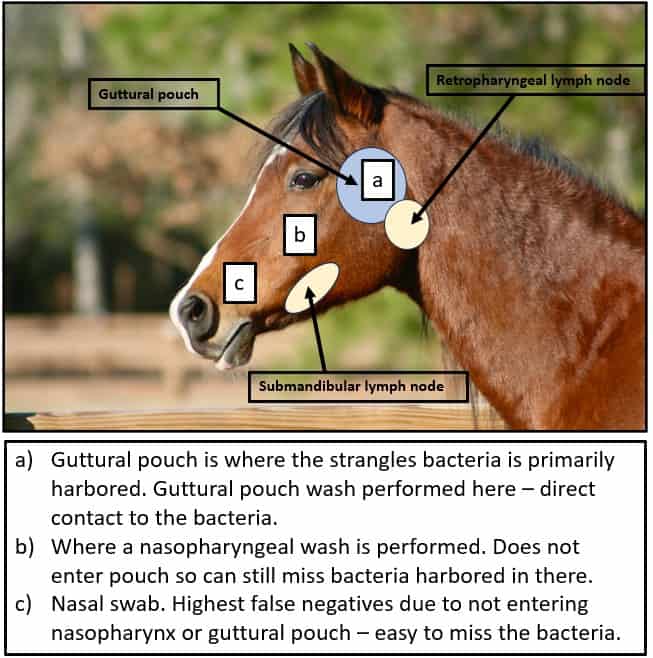When it comes to diagnosing strangles (Streptococcus equi subsp. equi), we can choose from four diagnostic testing methods. But why do we recommend the testing we do?
- Guttural pouch lavage. This is the gold standard diagnostic for strangles testing. Strangles-causing bacteria primarily shelter within the guttural pouch, so to perform this test we use endoscopy to guide us directly into the pouch where we can flush it with saline and collect a test sample. While this is the more expensive approach upfront, it is also the most accurate. A single negative test sample is adequate to clear a horse from isolation.
- Nasopharyngeal wash. This is the second-best strangles test. It requires passing a tube via the nostrils into the nasopharynx (throat region), flushing saline, and collecting and submitting a sample. This approach does not enter the guttural pouch, so if the bacteria are present but not outside the guttural pouch, the horse has a moderate chance of getting a false negative (meaning a horse that’s positive for the disease receives a negative result). Because of the false negative concern, you must have three negative nasopharyngeal washes to clear a horse from isolation. The cost of three washes is about the same as a single guttural pouch lavage but spread out over three visits/testing times.
- Nasal swab. Unfortunately, this commonly used test has a very high false negative readout rate because the sample is taken at such a low depth in the nasal passage. Unless the horse has active nasal discharge, which in strangles cases typically sheds from the guttural pouch, you shouldn’t rely on this testing method for isolation protocols and strangles diagnosis.
- Pus sample. If your horse has a draining abscess from a lymph node, we can submit a pus sample for culture with high accuracy.
Q: How long does it take to receive results?
A: The sample preliminary results are available within 24-48 hours after being shipped from the clinic.
Q: Why do we often recommend a full respiratory panel test instead of just testing for strangles?
A: Submitting samples for both strangles and the full respiratory panel at the same time can help expedite diagnosis. If your veterinarian suspects your horse has strangles but that test comes back negative, the full respiratory panel results help us determine what is causing the horse’s symptoms.
Q: Why do we sometimes culture the sample if it comes back negative for strangles?
A: If the initial sample is negative for Streptococcus equi subsp. equi, we’ll often plate a backup culture to ensure we didn’t miss anything. The upside is the culture will also identify Streptococcus zooepidemicus. This bacterium can cause nasal discharge and lymphadenopathy but is a normal, commensal bacteria of the upper airway that’s not contagious to other horses. Culture results can take three to five days.
